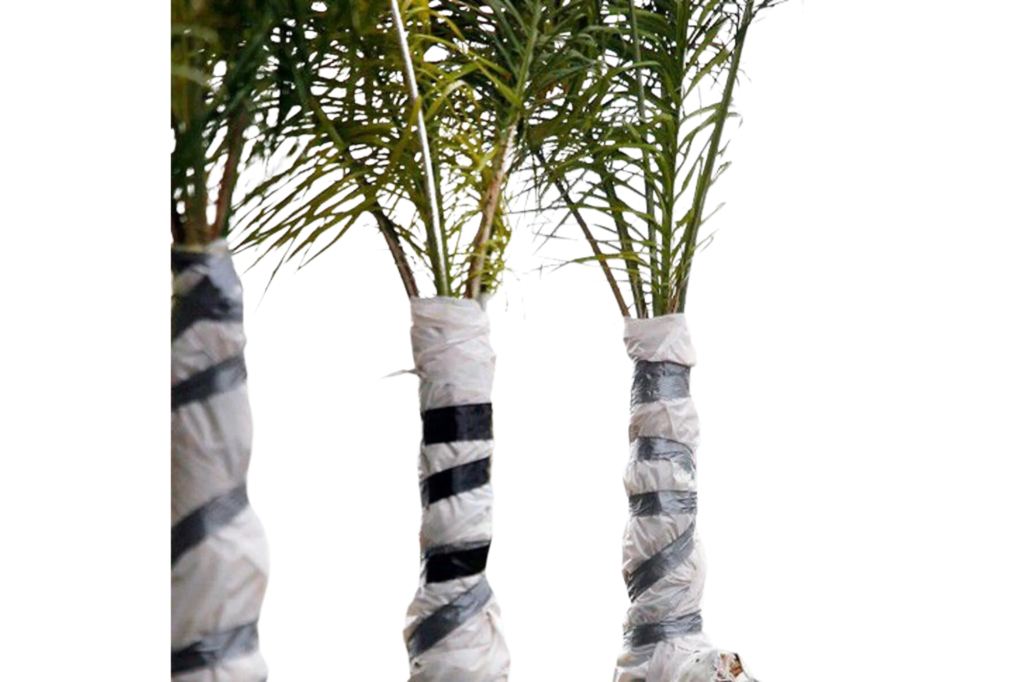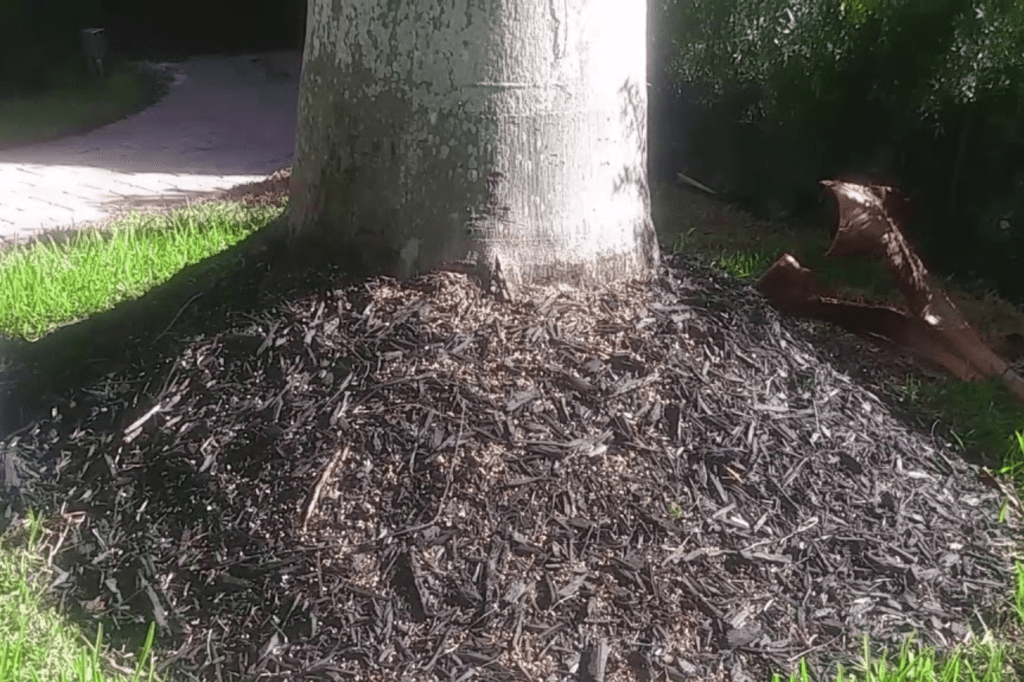Are you worried about how to keep your palm tree alive during the winter months? Don’t fret, because we’ve got you covered!
With the right precautions and care, you can ensure the survival of your beloved palm tree, even in the harshest winter conditions. In this article, we will guide you through the essential steps to protect your palm tree and maintain its health and vitality throughout the cold season.
From understanding your palm tree’s cold hardiness to providing adequate insulation and protection, we will cover all the necessary measures you need to take. We’ll also discuss mulching, proper watering techniques, pruning, and how to monitor and adjust for temperature fluctuations.
Additionally, we’ll explore options for indoor or container planting and when it’s best to seek professional help. By following our expert advice, you can ensure the safety and well-being of your palm tree all winter long.
Quick Summary
- Wrap the trunk with burlap or blankets for insulation
- Mulch the base of the tree to insulate roots
- Water sparingly to prevent root rot
- Provide adequate insulation and protection with frost cloth or blankets
Understand Your Palm Tree’s Cold Hardiness
To keep your palm tree thriving during the winter months, you’ll want to understand just how cold-hardy it is. Different palm tree species have varying levels of cold tolerance, so it’s important to know which type you have.
Some palm trees, like the Windmill Palm, can withstand temperatures as low as 10 degrees Fahrenheit, while others, like the Coconut Palm, are more sensitive and can only handle temperatures above 40 degrees Fahrenheit.
Once you know the cold hardiness of your palm tree, you can take the necessary steps to protect it during the winter. Here are some winter care tips to keep your palm tree healthy and safe:
- Provide insulation: Wrap the trunk of your palm tree with burlap or blankets to protect it from freezing temperatures. This will help prevent damage to the sensitive inner tissue.
- Mulch the base: Apply a layer of mulch around the base of the palm tree to help insulate the roots and retain moisture. This will provide additional protection against freezing temperatures.
- Water sparingly: During the winter months, reduce the amount of water you give to your palm tree. Overwatering can lead to root rot, especially when the soil doesn’t dry out quickly in colder temperatures.
- Avoid pruning: Refrain from pruning your palm tree during the winter. Pruning can stimulate new growth, which is more vulnerable to cold damage. Wait until the spring to trim any dead or damaged fronds.
By understanding your palm tree’s cold hardiness and following these winter care tips, you can ensure that your palm tree stays healthy and survives the winter months.
Provide Adequate Insulation and Protection
Ensuring sufficient insulation and protection is essential for maintaining the health of a palm tree during the colder months. When winterizing your palm tree, it’s crucial to implement frost protection measures to shield it from the harsh elements.
The first step is to wrap the trunk with burlap or frost cloth, securing it with twine or tape. This will create a barrier against freezing temperatures and help retain heat.
Next, cover the entire canopy of the tree with a frost cloth or blanket, making sure it reaches all the way to the ground. This will provide additional insulation and shield the delicate fronds from frost damage.
It’s also important to water the tree thoroughly before a freeze, as moist soil retains heat better than dry soil.
Lastly, consider using heat sources such as outdoor heating lamps or Christmas lights to generate warmth around the tree.
These winterizing techniques will protect your palm tree and increase its chances of surviving the cold winter months. Remember, taking these precautions is crucial for the safety and well-being of your palm tree.
Mulch Around the Base of the Tree
By adding a layer of mulch around the base of your palm tree, you can create a protective barrier that retains moisture and insulates the roots during the colder months. This simple step can greatly increase the chances of keeping your palm tree alive during winter.
Here are four important things to keep in mind when mulching around your palm tree:
- Depth: Apply a layer of mulch that’s about 3 to 4 inches deep. This’ll provide enough insulation without suffocating the roots.
- Material: Use organic mulch like wood chips or shredded bark. This type of mulch not only retains moisture but also breaks down over time, enriching the soil.
- Spread: Make sure the mulch extends at least 2 feet from the base of the palm tree. This wide coverage helps protect a larger area and prevents water runoff.
- Additional Measures: Consider using heat lamps to provide extra warmth during extreme cold spells. You can also apply anti-transpirants to the palm tree leaves to reduce water loss through transpiration.
By following these mulching tips and taking additional measures, you can create a safe environment for your palm tree during the winter months.
Water Appropriately
Make sure you water your palm tree properly to ensure its health throughout the colder months. Winter watering is crucial for the survival of your palm tree, especially since it might not be able to get enough water from rainfall during this time. You need to be cautious and water your palm tree appropriately to help it withstand the cold temperatures.
When it comes to winter watering, it’s important to strike a balance. You don’t want to overwater your palm tree, as excessive moisture can lead to root rot and other diseases. On the other hand, you don’t want to underwater it either, as this can cause dehydration and damage to the tree.
To water your palm tree effectively in winter, consider its cold tolerance. Some palm trees are more cold-tolerant than others, so be sure to research the specific needs of your tree. Generally, it’s best to water your palm tree when the soil feels dry to the touch. This ensures that the tree gets enough moisture without being saturated.
Remember, proper winter watering is essential for the health and survival of your palm tree. By following these guidelines and understanding your tree’s cold tolerance, you can help your palm tree thrive even in the coldest months. Stay vigilant and keep your palm tree safe and hydrated throughout the winter season.
Prune Dead or Damaged Fronds
Pruning dead or damaged fronds is an important task during the winter months, as it helps promote the overall health and vitality of your palm tree. By removing these fronds, you can prevent potential safety hazards and encourage new growth in the spring.
When pruning, it’s crucial to use proper techniques to ensure the best results. First, look out for signs of frost damage on the fronds. Frost damage can cause discoloration, wilting, or even death of the fronds. If you notice any of these signs, make sure to prune them immediately.
Start by cutting the fronds at the base, near the stem, using sharp and clean pruning shears. Be cautious while pruning, as some fronds can be heavy and may fall unexpectedly, posing a risk of injury. Remember to wear protective gloves and goggles to keep yourself safe from any potential harm.
Additionally, it’s important to dispose of the pruned fronds properly to prevent the spread of diseases or pests. Bag them up and dispose of them in accordance with your local regulations.
By following these pruning techniques and paying attention to signs of frost damage, you can help keep your palm tree healthy and thriving throughout the winter months.
Monitor and Adjust for Temperature Fluctuations
To ensure your palm tree thrives during the winter, pay close attention to temperature fluctuations and make necessary adjustments. The cold weather can be tough on your palm tree, so it’s important to monitor the soil and adjust the watering accordingly.
Here are three important steps to take when it comes to monitoring and adjusting for temperature fluctuations:
- Monitor the soil moisture: Check the soil regularly to ensure it isn’t too dry or too wet. Stick your finger about an inch deep into the soil, and if it feels dry, it’s time to water. However, if it feels moist, hold off on watering as overwatering can lead to root rot.
- Adjust watering: During the winter, your palm tree will require less water compared to the warmer months. Reduce the frequency of watering, but make sure to give it a thorough soak when you do water. This will help the roots absorb the necessary moisture without promoting waterlogging.
- Protect from extreme cold: If you live in an area with extremely cold temperatures, consider providing some extra protection for your palm tree. Cover it with a frost cloth or wrap it with burlap to help insulate it and prevent damage from freezing temperatures.
By monitoring the soil moisture and adjusting the watering accordingly, you’ll ensure that your palm tree stays healthy and safe during the winter months.
Consider Indoor or Container Options
If you’re looking for a way to bring a touch of tropical paradise into your home during the winter months, you might want to consider exploring indoor or container options for palm trees.
Indoor gardening and container gardening provide a safe and convenient way to keep your palm tree alive and thriving throughout the colder months. Indoor gardening allows you to create a controlled environment for your palm tree, ensuring that it receives the right amount of light, humidity, and temperature. Choose a well-lit area in your home, preferably near a window where your palm tree can receive ample sunlight. Consider using grow lights if natural light is limited. To maintain the right humidity levels, mist the leaves regularly or place a tray of water nearby.
Container gardening offers flexibility, allowing you to move your palm tree around as needed. Select a large enough container that provides adequate drainage. Use a well-draining potting mix to ensure proper moisture levels. Remember to water your palm tree regularly, but be careful not to overwater as this can lead to root rot.
Both indoor and container gardening options provide a safe and manageable way to keep your palm tree alive in the winter. By following these simple steps, you can enjoy the beauty and tropical vibes of your palm tree all year round.
Seek Professional Help if Necessary
Don’t hesitate to reach out to a professional if you need assistance with caring for your palm tree during the winter months. They have the expertise to guide you through the process and ensure your palm tree stays alive and healthy.
Here are some important things to keep in mind:
- DIY winterizing techniques: If you prefer to take care of your palm tree yourself, there are several techniques you can try to protect it from the cold. These include wrapping the trunk with burlap, mulching the base, and covering the tree with a frost cloth.
- Common signs of palm tree cold damage: It’s essential to know the signs of cold damage to catch any issues early on. Look out for wilting or yellowing fronds, brown or black spots on the leaves, and drooping or falling leaves. These signs indicate that your palm tree may be suffering from the cold and needs immediate attention.
- Consult a professional arborist: If you’re unsure about how to proceed or if your palm tree is showing severe signs of cold damage, it’s best to consult a professional arborist. They can assess the situation, provide expert advice, and offer appropriate treatments to revive your palm tree.
- Take preventative measures: To avoid cold damage altogether, consider planting cold-hardy palm tree species or keeping your palm tree in a container that can be moved indoors during the winter months. This way, you can ensure the safety and well-being of your palm tree all year round.
Remember, seeking professional help when needed and implementing proper winterizing techniques are crucial to keeping your palm tree alive and vibrant during the winter season.
Frequently Asked Questions
How often should I water my palm tree during winter?
During winter, water your palm tree sparingly to prevent overwatering, which can lead to root rot. Check the soil moisture by sticking your finger an inch deep. If it feels dry, water it. Protect the palm tree from freezing temperatures.
Can I cover my palm tree with a plastic sheet for insulation?
Yes, you can use burlap sacks for palm tree insulation. It is one of the techniques for protecting palm trees from frost. Covering your palm tree with a plastic sheet is not recommended.
Should I remove all the dead fronds from my palm tree during winter?
To protect your palm tree during winter, it is recommended to prune dead fronds. This will prevent them from potentially falling and causing damage. Ensure safety by removing any weak or hazardous branches.
Can I use regular garden soil as mulch for my palm tree?
Using regular garden soil as mulch for palm trees is not recommended. It can lead to nutrient imbalances and waterlogging. Instead, use organic mulch like wood chips. Effective alternatives to plastic sheeting for insulating palm trees include burlap or frost blankets.
What temperature is considered too cold for a palm tree to survive outside during winter?
Palm trees cannot survive in freezing temperatures. To protect them from frost, cover them with blankets or burlap and use a heat source nearby. Keep them well-watered and avoid pruning during winter.
Conclusion
In conclusion, by following these tips, you can successfully keep your palm tree alive during the winter months. Understanding your tree’s cold hardiness and providing insulation and protection are crucial.
Mulching around the base and watering appropriately will also help. Don’t forget to prune any dead or damaged fronds. Keep a close eye on temperature fluctuations and make adjustments as needed.
If all else fails, consider bringing your palm tree indoors or seeking professional assistance. With proper care, your palm tree can thrive all year round.











